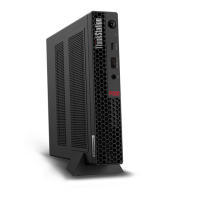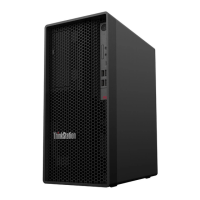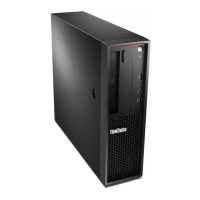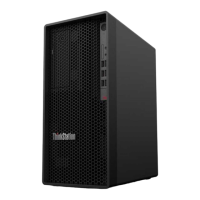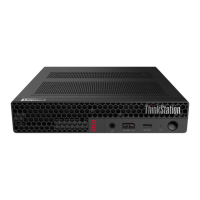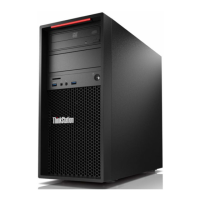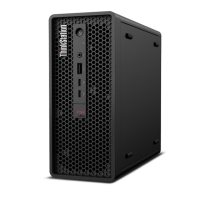Do you have a question about the Lenovo ThinkStation P350 and is the answer not in the manual?
Identifies components on the front of the computer, including buttons, indicators, and ports.
Details the connectors and ports located on the rear of the computer.
Describes the types and locations of internal storage drives and slots.
Lists the main features and technical specifications of the computer.
Details the different USB connector types and their capabilities.
Provides instructions on connecting to wired and wireless networks.
Explains how to connect monitors or projectors to the computer.
Details how to use a smart cable clip for cable management.
Introduces the Lenovo Vantage app for system maintenance and support.
Explains how to configure power management settings for energy efficiency.
Describes methods for transferring files, including Bluetooth and media cards.
Guides on connecting Bluetooth devices like keyboards and mice.
Explains methods to secure the computer physically, including padlocks and E-locks.
Details how to manage UEFI BIOS passwords and other security features.
Covers Smart USB Protection and software security solutions like firewalls.
Covers entering, navigating, and basic settings like display language and date/time in UEFI BIOS.
Details boot order, port control, performance modes, and OS installation settings in BIOS.
Provides procedures for updating UEFI BIOS, recovering from failures, and clearing CMOS.
Explains RAID concepts, levels, and how to enable/configure RAID in BIOS and UEFI.
Details procedures for deleting RAID volumes and resetting drives to non-RAID.
Outlines the initial steps and prerequisite checks for resolving computer issues.
Addresses common problems related to startup, audio, storage, optical drives, and USB devices.
Solutions for network connectivity, system performance, software errors, and using diagnostic tools.
Guides on restoring the system, resetting the computer, and using recovery media.
Lists CRUs and provides general guidelines for component replacement.
Instructions for replacing storage drives, M.2 slots, optical drives, and cages.
Procedures for replacing fans, heat sinks, chassis beams, memory, and coin-cell battery.
Steps to replace the power supply and E-lock security device.
Accessing self-help, product manuals, and support websites.
Using Vantage app and Windows recovery options for system maintenance.
Guidance on preparing for and contacting Lenovo customer support for assistance.
Information on services covered under warranty and options for purchasing additional services.
Details product certifications, compliance, and environmental operating conditions.
Provides important legal notices, disclaimers, and warranty information.
Lists trademarks associated with Lenovo and other companies.
Identifies components on the front of the computer, including buttons, indicators, and ports.
Details the connectors and ports located on the rear of the computer.
Describes the types and locations of internal storage drives and slots.
Lists the main features and technical specifications of the computer.
Details the different USB connector types and their capabilities.
Provides instructions on connecting to wired and wireless networks.
Explains how to connect monitors or projectors to the computer.
Details how to use a smart cable clip for cable management.
Introduces the Lenovo Vantage app for system maintenance and support.
Explains how to configure power management settings for energy efficiency.
Describes methods for transferring files, including Bluetooth and media cards.
Guides on connecting Bluetooth devices like keyboards and mice.
Explains methods to secure the computer physically, including padlocks and E-locks.
Details how to manage UEFI BIOS passwords and other security features.
Covers Smart USB Protection and software security solutions like firewalls.
Covers entering, navigating, and basic settings like display language and date/time in UEFI BIOS.
Details boot order, port control, performance modes, and OS installation settings in BIOS.
Provides procedures for updating UEFI BIOS, recovering from failures, and clearing CMOS.
Explains RAID concepts, levels, and how to enable/configure RAID in BIOS and UEFI.
Details procedures for deleting RAID volumes and resetting drives to non-RAID.
Outlines the initial steps and prerequisite checks for resolving computer issues.
Addresses common problems related to startup, audio, storage, optical drives, and USB devices.
Solutions for network connectivity, system performance, software errors, and using diagnostic tools.
Guides on restoring the system, resetting the computer, and using recovery media.
Lists CRUs and provides general guidelines for component replacement.
Instructions for replacing storage drives, M.2 slots, optical drives, and cages.
Procedures for replacing fans, heat sinks, chassis beams, memory, and coin-cell battery.
Steps to replace the power supply and E-lock security device.
Accessing self-help, product manuals, and support websites.
Using Vantage app and Windows recovery options for system maintenance.
Guidance on preparing for and contacting Lenovo customer support for assistance.
Information on services covered under warranty and options for purchasing additional services.
Details product certifications, compliance, and environmental operating conditions.
Provides important legal notices, disclaimers, and warranty information.
Lists trademarks associated with Lenovo and other companies.
| Form Factor | Tower |
|---|---|
| Chipset | Intel W580 |
| Memory | Up to 128GB DDR4 ECC or non-ECC |
| Storage | Up to 2x M.2 PCIe SSD and 2x 3.5" SATA HDD |
| Graphics | Up to NVIDIA RTX A5000 |
| Operating System | Windows 11 Pro, Windows 10 Pro, Ubuntu Linux |
| Power Supply | 500W Platinum |
| Front Ports | 2 x USB 3.2 Gen 1 Type-A, 1 x Headphone/Microphone Combo Jack |
| Rear Ports | 4x USB 3.2 Gen 1 Type-A |
| Processor Options | Up to 11th Gen Intel Core i9 or Intel Xeon W processors |
